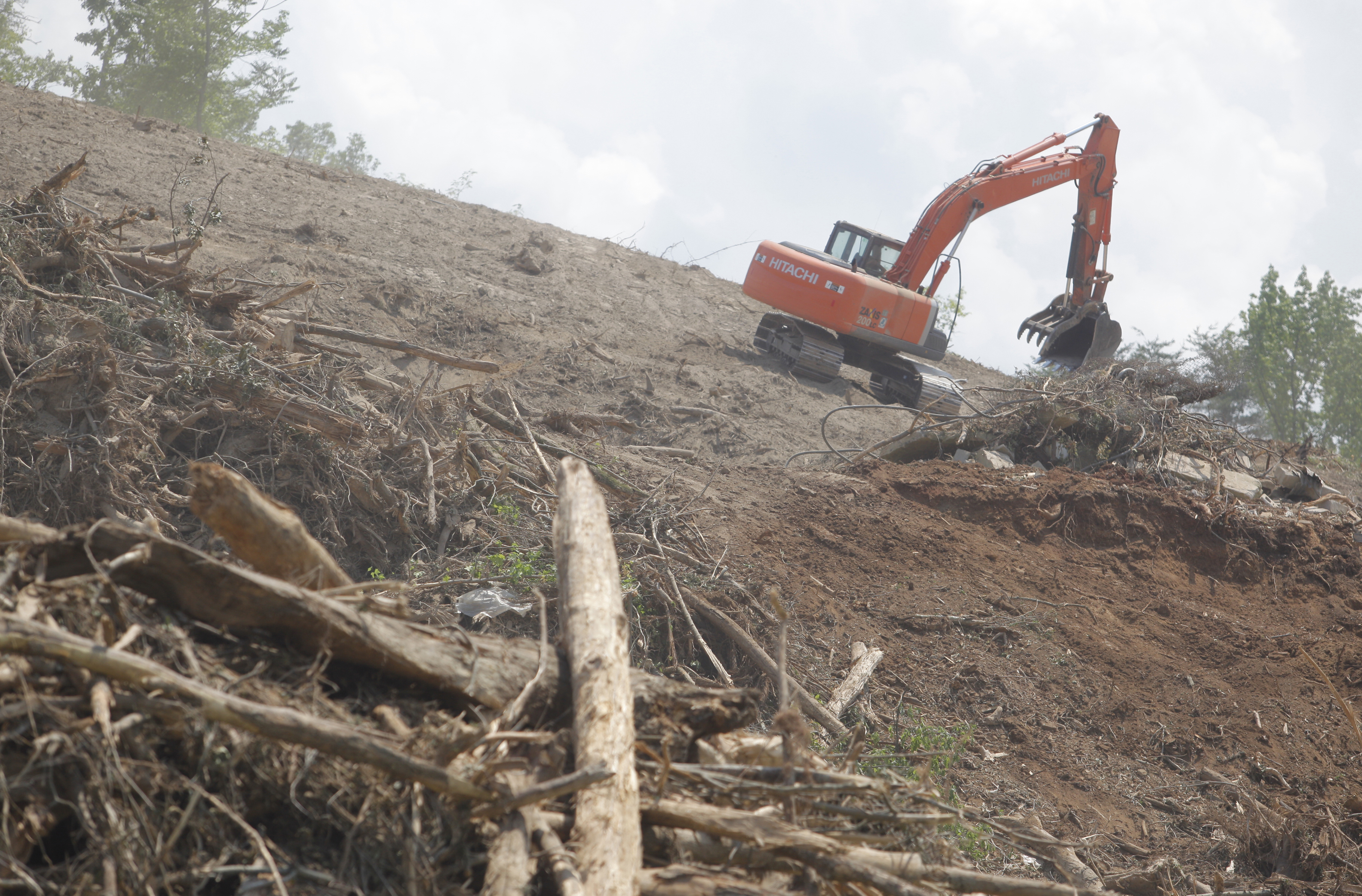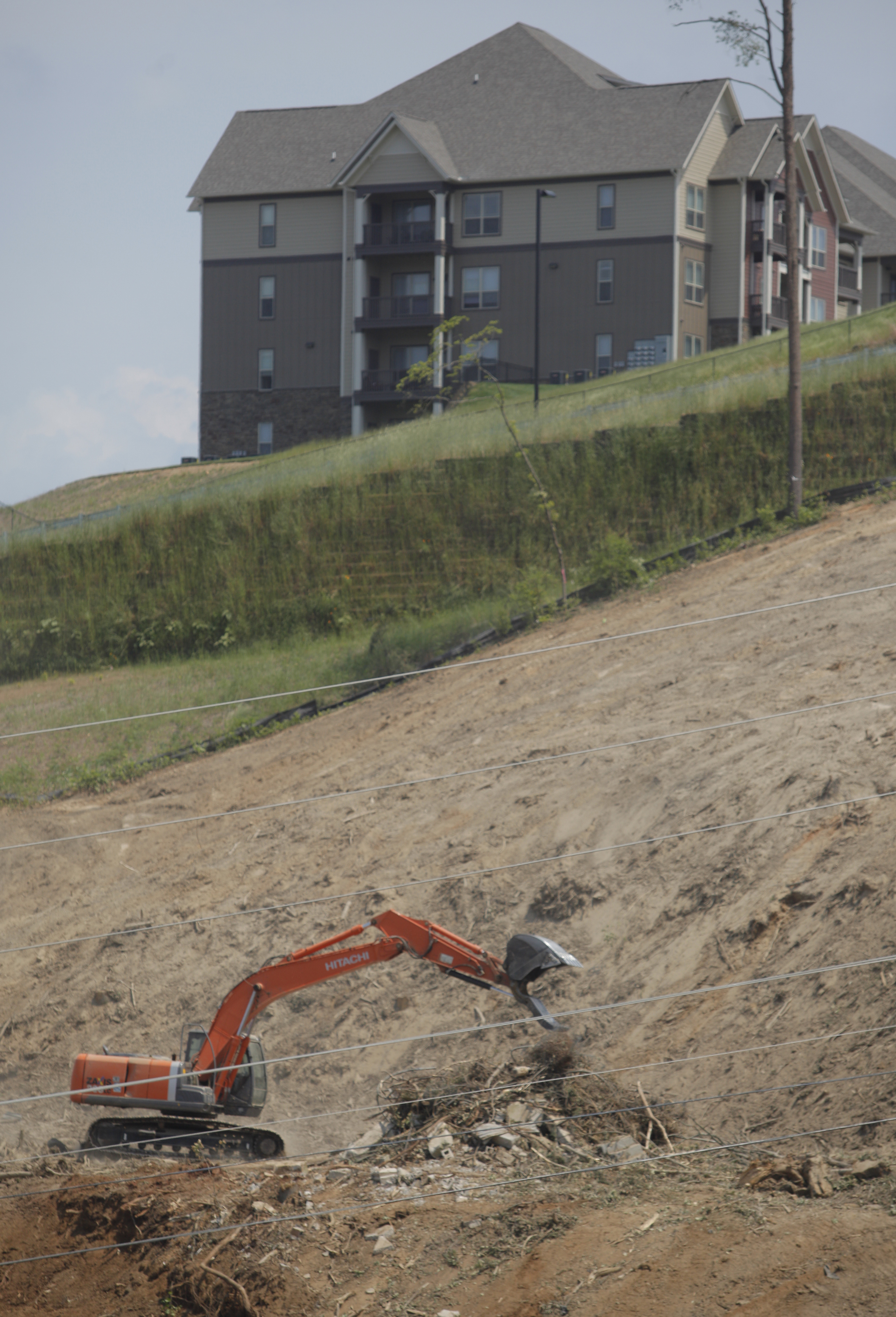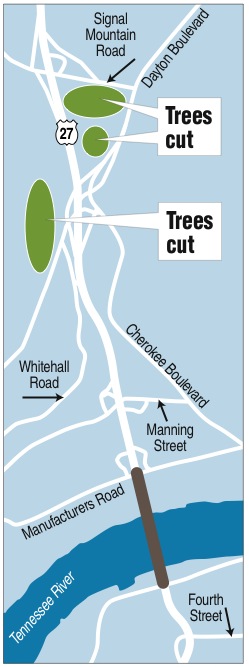Video: Hundreds of trees come down along Stringer's Ridge for U.S. Highway 27 work
Friday, January 1, 1904
 Paul Lovingood uses a trackhoe to move debris on the hill below the CityGreen apartment complex on May 1. Greg and Paul Lovingood, with West Contracting Inc., are clearing the hillsides along U.S. Highway 27 for a massive expansion of the highway that will include 31 retaining walls between Signal Mountain Road and the Olgiati Bridge.
Paul Lovingood uses a trackhoe to move debris on the hill below the CityGreen apartment complex on May 1. Greg and Paul Lovingood, with West Contracting Inc., are clearing the hillsides along U.S. Highway 27 for a massive expansion of the highway that will include 31 retaining walls between Signal Mountain Road and the Olgiati Bridge.questions about the project
Q: Are they going to build the road way up there?A: No, but it does now look that way as roadbuilders cut dirt access roads at the tops of the slopes for the highest terraces of retaining walls.Q: If there's a big rainstorm, is all that dirt going to end up on U.S. 27?A: Roadbuilders certainly hope not. They have erosion control barriers up, but if Mother Nature brings them a 3-inch rain, things might get muddy.Q: How many trees have been removed?A: An estimated 500 "mature" trees already are gone.Q: How many more trees will be removed?A: An estimated 775 still will fall. In all, about 51 acres of trees will be removed.Q: What will happen to the felled trees?A: They are sent to sawmills, pulp mills or mulch grinders.Q: What will this look like when it's done?A: Terraces of cut rock walls with grass or vetch sown between them for cover.Q: Could TDOT contract or partner with wildflower growers, or plant wildflower seed?A: No. Wildflower meadows take too long to become established, leaving the slopes exposed to erosion.
The once tree-lined drive along Stringer's Ridge on U.S. Highway 27 between Red Bank and Chattanooga is becoming treeless.
Hundreds of mature trees have come down in the past two months, and still more will fall as hillside after hillside is scoured in preparation for road widening and 31 massive concrete retaining walls.
The walls -- with a cut-stone face and terracing up the sides of Stringer's steep slopes -- will become the new edging of progress.
The 1.6-mile stretch of road will be widened from four lanes to six and occasionally eight as side-saddle ramp lanes come and go.
What will the city's northern gateway look like when it's all done?
"It's going to look like a big, rocked canyon," said Ken Flynn, the Tennessee Department of Transportation's regional project manager.
But given the geography and the road's layout in the canyon between folds of the ridge, there's little other option if the 50-year-old highway is to handle today's increasing traffic from the growing northern end of the county.
"This road was built in the early 1960s, and it's reached its design life," Flynn said.
In morning and afternoon rush hours, traffic slows to a crawl, he said.
Eventually, what some city residents and officials are calling "an eyesore" will be completed and become a new convenience, but in the meantime, even Flynn concedes that road building is not necessarily a pretty sight.
"It's going to look like a bomb went off here for a while," he said.
The $102.5 million project is expected to be complete by October 2014.
Complications abound
For Flynn, the short stretch of road is the most complicated project he's ever handled because there's a lot going on in a very small space.
The steep hillsides have been made even more unstable by new developments built along their tops, and when the Tennessee Department of Transportation began planning the new road, those developments were not there.
The developments along the ridge crest of Whitehall Road to the west of U.S. 27 prompted TDOT engineers to add a 31st retaining wall. And the new CityGreen Apartments that front Dayton Boulevard built retaining walls with living plants that have given road builders indigestion.
"We don't want to do anything that disturbs their walls," Flynn said.
So special extras are going into the slope planning and retaining walls on the east side of the U.S. 27 canyon, too, he said.
 Paul Lovingood moves debris in a track-hoe on the hill below the CityGreen apartment complex on Tuesday, May 1, 2012. Greg and Paul Lovingood with West Contracting Inc. continued construction for the Highway 27 expansion south of the intersection of the highway and Signal Mountain Road. The pair were using a track-hoe and a grubbing tractor to clear debris.
Paul Lovingood moves debris in a track-hoe on the hill below the CityGreen apartment complex on Tuesday, May 1, 2012. Greg and Paul Lovingood with West Contracting Inc. continued construction for the Highway 27 expansion south of the intersection of the highway and Signal Mountain Road. The pair were using a track-hoe and a grubbing tractor to clear debris.At the same time they widen the road, builders must tear out 10 bridges and build back six -- sometimes connecting what had been two narrower bridges to become one much wider one.
There's also the possibility of hitting Chattanooga shale, a black acid-bearing rock that contains pyrite. When exposed to air and water, the rock can produce sulfuric acid and radon, which already has happened once in this same section of road.
The 2005 project to rework the Signal Mountain Road entrance ramp to U.S. 27 uncovered a room-sized pocket of the rock, requiring a $408,000 cap. The project's $2.2 million cost jumped to $2.6 million.
Beautification?
Richard Beeland, spokesman for Chattanooga Mayor Ron Littlefield, said discussions already have begun to find a way to soften the "rock canyon."
"Nobody's complaining, really," Beeland said. "I think everyone knows they're just doing what they have to do to get the road built. But we are talking about what to do to take away the hard lines."
Flynn said Friday that plans called for 68 acres of the 99-acre project to be "disturbed." He estimated that 75 percent of the disturbed area, or 51 acres, contains trees that have been or will be removed.
"Assuming that there are approximately 25 mature trees greater than 6 inches in diameter per acre, we have cleared approximately 500 trees, with 775 trees still to remove," he said.
The harvested trees are being sent off to sawmills or pulp mills or are ground for mulch, so they will be recycled in some way, he said.
The state will then seed or sod the terraced hills with grass for fast erosion control.
"I have to get coverage quick," he said. "Wildflower seeds and covers take too long."
But he said the Department of Transportation will work with the city and others and will have no problem with approved plantings that the city or groups -- not the state -- will maintain. Trees would not have a high approval rating, however, since their root masses could grow to disturb the retaining walls.
City Forester Gene Hyde said he is surprised at how many trees have been cut for the project.
"But that just gives us a bigger canvas on which to paint," he said of the conversations he and city planners will have with the state.
"We would like to explore some options," he said. "I'm thinking trees. As a forester, I always think trees. But whatever we do, it's going to be a good conclusion to what is kind of an eyesore right now."
Contact staff writer Pam Sohn at psohn@timesfree press.com or 423-757-6346.

